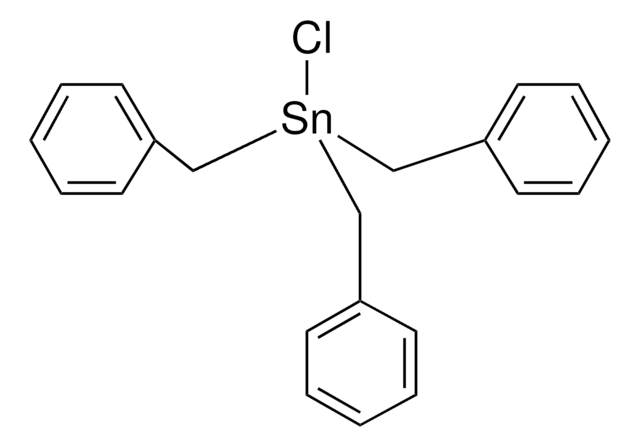265640
Tin
powder, <150 μm, 99.5% trace metals basis
Sinônimo(s):
Sn
Faça loginpara ver os preços organizacionais e de contrato
About This Item
Fórmula empírica (Notação de Hill):
Sn
Número CAS:
Peso molecular:
118.71
Número CE:
Número MDL:
Código UNSPSC:
12161600
ID de substância PubChem:
NACRES:
NA.22
Produtos recomendados
Nível de qualidade
Ensaio
99.5% trace metals basis
forma
powder
adequação da reação
core: tin
reagent type: catalyst
resistividade
11 μΩ-cm, 20°C
tamanho de partícula
<150 μm
pb
2270 °C (lit.)
pf
231.9 °C (lit.)
densidade
7.310 g/mL at 25 °C (lit.)
cadeia de caracteres SMILES
[Sn]
InChI
1S/Sn
chave InChI
ATJFFYVFTNAWJD-UHFFFAOYSA-N
Categorias relacionadas
Descrição geral
Tin is an efficient catalyst for the polycondensation of lactic acid to synthesize poly(lactic acid).
Aplicação
With HCl, reduces a variety of functional groups; stereoselective allylation of carbonyl compounds; in situ generation of tin enolates for directed aldol reactions.
Código de classe de armazenamento
13 - Non Combustible Solids
Classe de risco de água (WGK)
WGK 3
Ponto de fulgor (°F)
Not applicable
Ponto de fulgor (°C)
Not applicable
Equipamento de proteção individual
dust mask type N95 (US), Eyeshields, Gloves
Escolha uma das versões mais recentes:
Já possui este produto?
Encontre a documentação dos produtos que você adquiriu recentemente na biblioteca de documentos.
Os clientes também visualizaram
P Olmedo et al.
Environment international, 59, 63-72 (2013-06-25)
Although fish intake has potential health benefits, the presence of metal contamination in seafood has raised public health concerns. In this study, levels of mercury, cadmium, lead, tin and arsenic have been determined in fresh, canned and frozen fish and
Lun Li et al.
Journal of the American Chemical Society, 135(4), 1213-1216 (2013-01-15)
Single-layer single-crystalline SnSe nanosheet with four-atomic thickness of ~1.0 nm and lateral size of ~300 nm is presented here by using a one-pot synthetic method. It is found that 1,10-phenanthroline plays an important role in determining the morphology of the
Rutile-type (Ti,Sn)O₂ nanorods as efficient anode materials toward its lithium storage capabilities.
Yu-Chun Chen et al.
Nanoscale, 5(6), 2254-2258 (2013-02-13)
A series of rutile-type (Ti,Sn)O2 solid solutions with nanorod architecture were successfully synthesized in this study by varying their calcination temperatures of tin-modified titanium dioxide (Sn/TiO2) nanocomposites under a nitrogen atmosphere. During the delithiation process, the (Ti,Sn)O2 nanorods obtained at
Shiyou Chen et al.
Advanced materials (Deerfield Beach, Fla.), 25(11), 1522-1539 (2013-02-13)
The kesterite-structured semiconductors Cu2ZnSnS4 and Cu2ZnSnSe4 are drawing considerable attention recently as the active layers in earth-abundant low-cost thin-film solar cells. The additional number of elements in these quaternary compounds, relative to binary and ternary semiconductors, results in increased flexibility
D B Shpakovsky et al.
Dalton transactions (Cambridge, England : 2003), 41(48), 14568-14582 (2012-10-12)
Four new organotin(IV) complexes of bis-(2,6-di-tert-butylphenol)tin(IV) dichloride [(tert-Bu-)(2)(HO-Ph)](2)SnCl(2) (1) with the heterocyclic thioamides 2-mercapto-pyrimidine (PMTH), 2-mercapto-4-methyl-pyrimidine (MPMTH), 2-mercapto-pyridine (PYTH) and 2-mercapto-benzothiazole (MBZTH), of formulae {[(tert-Bu-)(2)(HO-Ph)](2)Sn(PMT)(2)} (2), {[(tert-Bu-)(2)(HO-Ph)](2)Sn(MPMT)(2)} (3), {[(tert-Bu-)(2)(HO-Ph)](2)SnCl(PYT)} (4) and {[(tert-Bu-)(2)(HO-Ph)](2)SnCl(MBZT)} (5), have been synthesized and characterized by elemental
Artigos
Nanomaterials for Energy Storage in Lithium-ion Battery Applications
Nossa equipe de cientistas tem experiência em todas as áreas de pesquisa, incluindo Life Sciences, ciência de materiais, síntese química, cromatografia, química analítica e muitas outras.
Entre em contato com a assistência técnica




